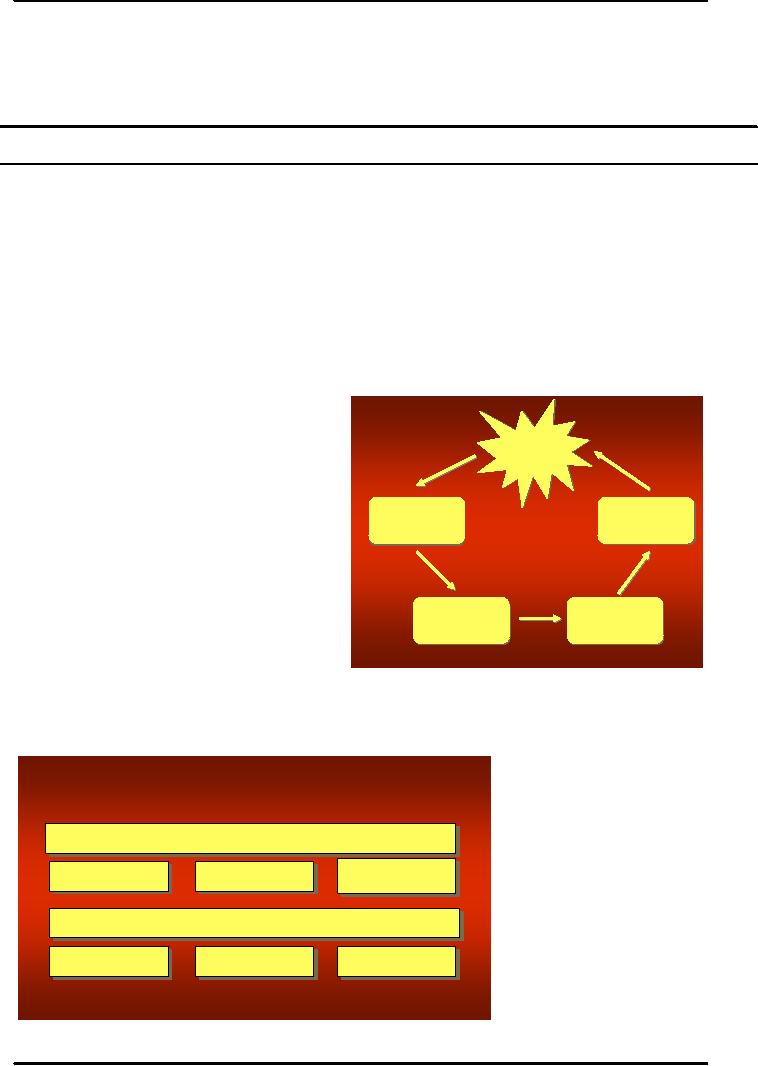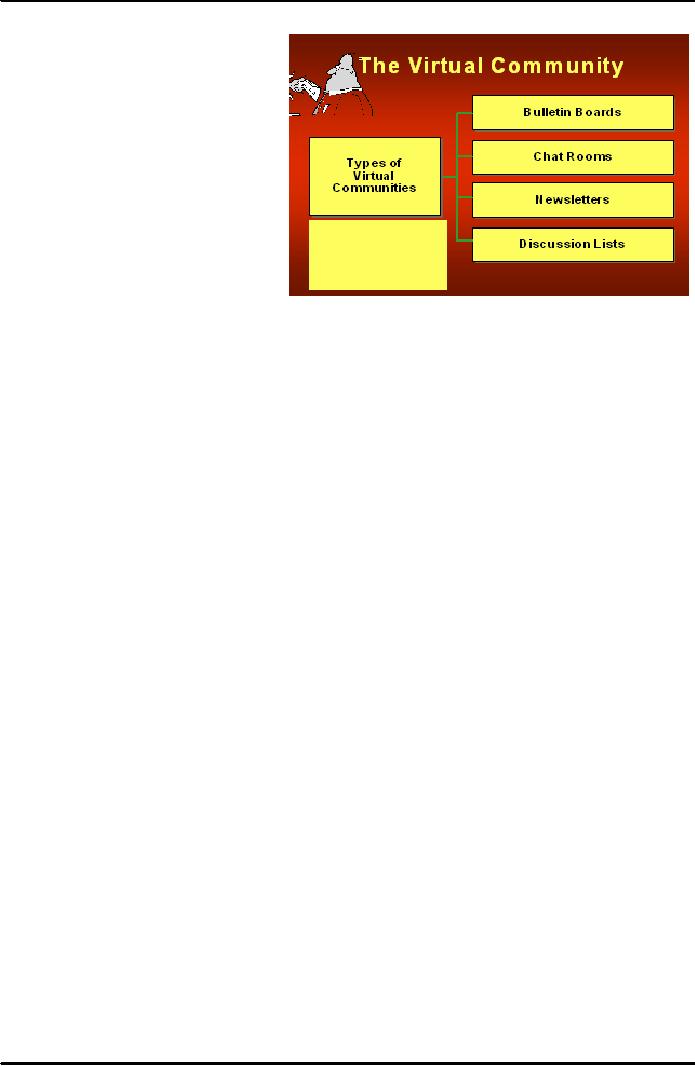 |

Principles
of Marketing MGT301
VU
Lesson
42
After
today's Lesson students should be able to
explain the importance of
the E. Marketing,
benefits of using
internet as a tool to reach
the customers, and at the
same time a tool to
do
business
in more effective and time
saving way.
A.
E-MARKETING
a.
Internet Marketing:
Internet
was used for the
first time in 1982. It began
to expand in 1991 with the
World Wide Web.
Internet
technologies pose managerial implications
to business. Marketers are using internet
as very
effective
tool of marketing
b.
Major Forces Shaping the
Digital Age:
Digitalization
and Connectivity: The flow
of digital information requires
connectivity which is
best
provided
by the Intranets, Extranets,
and the Internet. The
Internet explosion is the
key driver of
the
"new economy". New types of
the intermediaries are also
playing important role in the
shaping
of
digital age
c.
The Role of the Internet in
Marketing:
Internet
is very important tool in
marketing.
It
is useful for marketers in
different ways
like:
∑
It
is
the
fastest
growing
Internet
communication
technology.
∑
Within
the first five years, 50
million
people
were connected.
Telephone
Posttall Serviice
Pos
a Serv c
e
∑
Capable
of interactively
sharing
information
in real time.
Internet
is a new tool to reach
consumers
initially
different tools like telephone,
postal
Radio
Television
services,
radio and televisions were
used as a
source
to communicate to consumers but
now
days along with these tools
internet is
also
being used as a source to
reach and to communicate to
customers/consumers. Using
internet
companies
can provide their
information to customers through
websites, search engines can
be
used
to coordinate the consumers and
producers, customers can used the e.
mails to connect to
the
producers. Customers
and
consumers not only
The
Internet Pre senc e
acquire
information through
internet
but also can
make
online
purchases by placing
Engage
iiniinteractive,perrsonaliz
edcommuniications
Engage
n
nteractive, pe
sonaliz ed communcations
orders
to desired producers,
On--ine
On
lline
it
provides convenience and
E--mail
E
mail
Web
Siites
Web
Stes
BannerrAds
Banne
Ads
time
saving for both
Viirtualsttore
frontsand
iinventorysystte ms
Vrtual
s
ore fronts
and nventory sys e ms
Reduces
Lowerrsttorage
Lowe
s orage
Easy
access tto
Easy
access o
Reduces
IInventory
nventory
costts
cos
s
delliveryiinfo
deivery
nfo
212

Principles
of Marketing MGT301
VU
consumers
and producers, as shown in
the
fig.
Companies can reduce their
need of
inventory
stocks by using the
inventory
systems.
Online banners, ads, website
and e.
Busiiness--to--Consumerr
Bus
ne
ss
to
Co nsume
((B2C))
B
2C
mails
can be used as
personalized
Basiic Forms
Bas
c
Forms
communication
tools.
off
o
Ellecttroniic
E
ec ron c
Commerce
Commerce
d.
Electronic Commerce
Busiiness--to--Busiiness
Bus
ne
ss
to
Bu sn ess
((B2B))
B
2B
∑
E-Commerce-
The
process of
conducting
business transactions over
electronic
networks, mostly
the
Internet
∑
E-Marketing
: The
process of utilizing Information
Technology in the
conception,
distribution,
promotion, and pricing of
goods, services, and ideas
to create exchanges
that
satisfy
individual and organizational
objectives
∑
E-Business:
The
use of Information Technology in
all business tasks
including
production,
marketing, accounting, finance, and human
resources management
Basic
objective of the marketing is to use of 4
"P's" to meet customer's needs.
This objective is
best
achieved by using E. marketing in Supply Chain Management.
Technology can be used
to
increase
efficiency of marketing and increases
company profitability and
adds customer value
e.
Rules of E-Marketing:
General
rules of E. Marketing
are:
1.
Power Shift from sellers to
buyers
2.
Increasing Velocity
3.
Death of Distance
4.
Global reach
5.
Time compression
6.
Knowledge management is
key
7.
Market deconstruction
8.
Intellectual capital rules
f.
Buyer
Benefits of E-Commerce
∑
Convenience
∑
Easy
and private
∑
Greater
product access/selection
On--Liine
Markett
Share
On
L
n e Marke
Share
∑
Access
to
comparative
Salles
Levell
Sa
e
s
Leve
information
IInternet
nternet
Marketiing
RepeattPurchase
∑
Interactive
and immediate
Market
ng
Repea
Purchase
Objjectiives
Ob
ect ves
g.
Seller
Benefits
of
E-
MarkettPosiitiioniing
Marke
Pos t
o n n g
Commerce:
IImage
ma
ge
∑
Relationship
building
Brand
Awareness
∑
Reduced
costs
Brand
Awareness
∑
Increased
speed and efficiency
∑
Flexibility
∑
Global
access, global reach
213

Principles
of Marketing MGT301
VU
h.
Basic-Forms
i.
Virtual Business:
There
are two types of the
electronic
commerce
one is termed as business to
business
and second is termed as
business
to business electronic
commerce.
As the term indicates
business
to consumer commerce mean
consumer
acquires product
through
electronic
commerce for
consumption
purpose
while for business to
business
commerce
is used to sale the
product
for
further business processes.
What
ever
is the type of commerce it
requires connection between
the two parties which
are buyer and
the
seller. This connection and
the interaction are provided
by the virtual
communities.
Manufacturers
or sellers can use the
bulletin boards, chat rooms, newsletters
and discussion lists
for
communication process that
can facilitate the exchange
process between the buyers
and the
sellers.
Major source of effectiveness of
this system is dependent upon
the internet technology
that
is
changed the world into
global village.
j.
Key Success Factor for Internet
Businesses
Success
of the internet business
depends upon the offer of
value and customer driven
products
adjusting
the prices according to
products values, going for
specific customers instead of the
mass
marketing,
distributing the products
according to customer's convenience. Designing
the
marketing
mix that is 4ps in that way
which is beneficent for both customers
and producers.
k.
Internet Marketing Objectives
As
shown in the fig the
main objectives of the internet marketing
are, to have online market
share,
to
increase the sales level,
make customers to make repeat
purchases, market positioning,
image
building
of the company and creation of
awareness regarding the
brand of the company this
can be
created
by using different online promotional
tools on internet that
include bulletin advertisement,
button
advertisement, targeted E. mail etc. By
using these tools phenomenon of
the digital world is
being
created. Basic concept of the
phenomenon is to provide the value
products to the customers
with
speed. Pakistani manufacturers/ producers
can use the internet
technologies for the
development
of the businesses.
Some
advantages that can be
achieved by using internet
include:
it
can be used as a tool to do
business
increase
your customers base
increase
your efficiency and
effectiveness
cost
effective
time
saving
open
new venue
Can
become the part of global
economy through internet
marketing
214
Table of Contents:
- PRINCIPLES OF MARKETING:Introduction of Marketing, How is Marketing Done?
- ROAD MAP:UNDERSTANDING MARKETING AND MARKETING PROCESS
- MARKETING FUNCTIONS:CUSTOMER RELATIONSHIP MANAGEMENT
- MARKETING IN HISTORICAL PERSPECTIVE AND EVOLUTION OF MARKETING:End of the Mass Market
- MARKETING CHALLENGES IN THE 21st CENTURY:Connections with Customers
- STRATEGIC PLANNING AND MARKETING PROCESS:Setting Company Objectives and Goals
- PORTFOLIO ANALYSIS:MARKETING PROCESS,Marketing Strategy Planning Process
- MARKETING PROCESS:Analyzing marketing opportunities, Contents of Marketing Plan
- MARKETING ENVIRONMENT:The Companyís Microenvironment, Customers
- MARKETING MACRO ENVIRONMENT:Demographic Environment, Cultural Environment
- ANALYZING MARKETING OPPORTUNITIES AND DEVELOPING STRATEGIES:MIS, Marketing Research
- THE MARKETING RESEARCH PROCESS:Developing the Research Plan, Research Approaches
- THE MARKETING RESEARCH PROCESS (Continued):CONSUMER MARKET
- CONSUMER BUYING BEHAVIOR:Model of consumer behavior, Cultural Factors
- CONSUMER BUYING BEHAVIOR (CONTINUED):Personal Factors, Psychological Factors
- BUSINESS MARKETS AND BUYING BEHAVIOR:Market structure and demand
- MARKET SEGMENTATION:Steps in Target Marketing, Mass Marketing
- MARKET SEGMENTATION (CONTINUED):Market Targeting, How Many Differences to Promote
- Product:Marketing Mix, Levels of Product and Services, Consumer Products
- PRODUCT:Individual product decisions, Product Attributes, Branding
- PRODUCT:NEW PRODUCT DEVELOPMENT PROCESS, Idea generation, Test Marketing
- NEW PRODUCT DEVELOPMENT:PRODUCT LIFE- CYCLE STAGES AND STRATEGIES
- KEY TERMS:New-product development, Idea generation, Product development
- Price the 2nd P of Marketing Mix:Marketing Objectives, Costs, The Market and Demand
- PRICE THE 2ND P OF MARKETING MIX:General Pricing Approaches, Fixed Cost
- PRICE THE 2ND P OF MARKETING MIX:Discount and Allowance Pricing, Segmented Pricing
- PRICE THE 2ND P OF MARKETING MIX:Price Changes, Initiating Price Increases
- PLACE- THE 3RD P OF MARKETING MIX:Marketing Channel, Channel Behavior
- LOGISTIC MANAGEMENT:Push Versus Pull Strategy, Goals of the Logistics System
- RETAILING AND WHOLESALING:Customer Service, Product Line, Discount Stores
- KEY TERMS:Distribution channel, Franchise organization, Distribution center
- PROMOTION THE 4TH P OF MARKETING MIX:Integrated Marketing Communications
- ADVERTISING:The Five Mís of Advertising, Advertising decisions
- ADVERTISING:SALES PROMOTION, Evaluating Advertising, Sales Promotion
- PERSONAL SELLING:The Role of the Sales Force, Builds Relationships
- SALES FORCE MANAGEMENT:Managing the Sales Force, Compensating Salespeople
- SALES FORCE MANAGEMENT:DIRECT MARKETING, Forms of Direct Marketing
- DIRECT MARKETING:PUBLIC RELATIONS, Major Public Relations Decisions
- KEY TERMS:Public relations, Advertising, Catalog Marketing
- CREATING COMPETITIVE ADVANTAGE:Competitor Analysis, Competitive Strategies
- GLOBAL MARKETING:International Trade System, Economic Environment
- E-MARKETING:Internet Marketing, Electronic Commerce, Basic-Forms
- MARKETING AND SOCIETY:Social Criticisms of Marketing, Marketing Ethics
- MARKETING:BCG MATRIX, CONSUMER BEHAVIOR, PRODUCT AND SERVICES
- A NEW PRODUCT DEVELOPMENT:PRICING STRATEGIES, GLOBAL MARKET PLACE